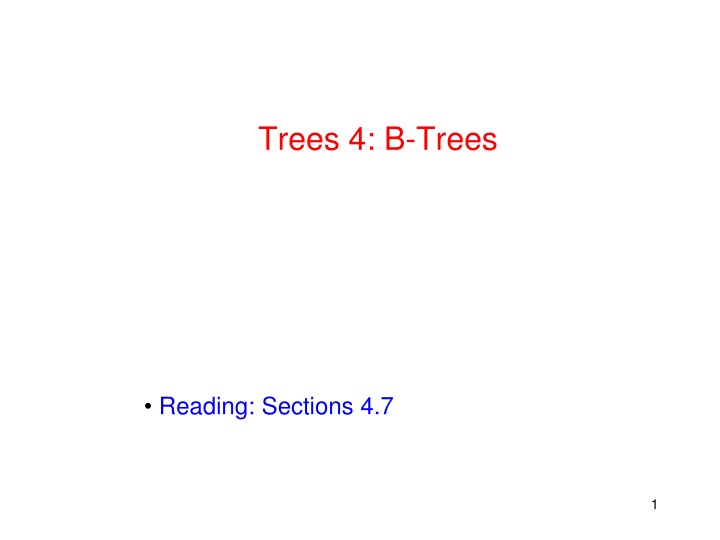
B-Trees and M-Ary Trees for Efficient Data Storage
Learn about B-Trees and M-Ary Trees, including their motivations, benefits, and impact on reducing disk accesses. Explore how increasing the number of children or degree in a tree can affect its height and performance. Discover the advantages of balanced binary search trees and M-ary search trees for organizing data effectively.
Download Presentation

Please find below an Image/Link to download the presentation.
The content on the website is provided AS IS for your information and personal use only. It may not be sold, licensed, or shared on other websites without obtaining consent from the author. If you encounter any issues during the download, it is possible that the publisher has removed the file from their server.
You are allowed to download the files provided on this website for personal or commercial use, subject to the condition that they are used lawfully. All files are the property of their respective owners.
The content on the website is provided AS IS for your information and personal use only. It may not be sold, licensed, or shared on other websites without obtaining consent from the author.
E N D
Presentation Transcript
Trees 4: B-Trees Reading: Sections 4.7 1
B-trees: motivation Balanced binary search tree ? = ?(lg ? ). Insert, remove, and search operations all have a complexity of ?(lg ? ) = ?(???2?). In a binary tree, each node has a maximum of 2 children. What if we increase the number of children to be a larger value? If we increase the number of children from 2 to C (C is a constant) and maintain a balanced tree, what would the tree height be? 2
B-trees: motivation C-ary tree in tree A complete C-ary tree (each node can have at most C children, C is a constant such as 1024) of height H has ? = ?0+ ?1+ + ?? ? =??+1 1 ? 1 ?? So ? ????? =???2(?) If we increase the maximum number of children from 2 to C and maintain a balanced tree, the tree height is reduced by a constant factor (???2(?)). If C = 1024, the height is reduced by a factor of ???21024 =10. Why not get the reduction with a large C? ???2(?) 3
B-trees: motivation Using a larger degree than 2 in tree If we increase the degree from 2 to C=1024, the height is reduced by a factor of 10. Reducing the tree height is not a clean-cut winner because the logic to decide which child to go to in each node also gets more complicated Needs a lot of comparisons to make the decision. For C=1024, if we do binary search over 1024 potential choices within each node, we will still need at least 10 comparisons to make the decision. 4
B-Trees motivation From the previous analysis, balanced binary tree should be good enough. The analysis assumes that computation within a node and accesses new tree nodes are all done in CPU. If the data does not fit in memory, some part of data may be stored on hard disk. CPU speed is in millions of instructions per second 3GHz machines Equals roughly 3000 million instructions per seconds Typical disk speeds about 7,200 RPM Roughly 120 disk accesses per second So accessing disk is incredibly expensive. So we will be willing to do more computation to organize our data better and make fewer disk accesses: computation with a node is done in CPU, traversal tree nodes may cause disk access (e.g. in database). 5
M-ary Trees Allows up to M children for each node Instead of max two for binary trees A complete M-ary tree of N nodes has a depth of logMN Example of complete 5-ary tree of 31 nodes 6
M-ary search tree Similar to binary search tree, except that Each node has (M-1) keys to decide which of the M branches to follow. Larger M smaller tree depth But how to make M-ary tree balanced? 7
Balanced M-ary search tree Two general approaches: 1. Restrict the tree shape like the AVL tree 2. (1) Restrict the number of children each node can have (e.g. each node must have at least M/2 children) and (2) force all leaves to be at the same level. 1. If each node must have at least M/2 children, the tree height ? ??? 2(?) B-Tree takes the second approach. With M being a large number, this is easier to maintain the balance property in this manner. 8
B-Tree (or Balanced Trees) B-Tree is an M-ary search tree with the following balancing restrictions 1. Data items are stored at the leaves 2. Non-leaf nodes store up to M-1 keys to guide the searching (keys are sorted within a node) Key i represents the smallest key in subtree (i+1) 3. The root can either be a leaf, or have between 2 to M children 4. All non-leaf nodes except the root have between ceil(M/2) and M children 5. All leaves are at the same depth and have between ceil(L/2) and L data items, for some L. 9
B-Tree Example (M=5, L=5) All leaves are in the same level How many children each node must have? How many data each leaf node must have? 10
B-Tree Example (M=5, L=5) All data are stored in the leaf nodes only Data in the non-leaf nodes can be derived from the data in the leaf nodes. The purpose of the non-leaf nodes is to find the data in the leaf nodes quickly. Such nodes are sometimes called indexing nodes. 11
B-Tree Example (M=5, L=5) Given the leaf nodes, logically how to populate the non-leaf nodes? The data in each non-leaf node are sorted (data are sorted in leaf nodes too). The i-th key in a node is the smallest data in the i+1 th subtree. If the leaf nodes in a B-tree is decided, the whole tree is decided! 12
B-Tree Example (M=5, L=5) What is the range of the data in the i+1 th subtree of a node? The i-th key in a node is the smallest data in the i+1 th subtree. 13
B-Tree Example (M=5, L=5) What is the range of the data in the i+1 th subtree of a node? The i-th key in a node is the smallest data in the i+1 th subtree. ???? ? < ????+1 14
B-tree search If ???? < ???0 then go to ???????0 If ???? ?????????? then go to ??????????????+1 Else ???? ???? < ????+1 then go to ????????+1 Try search 40, 58, 94, 71. 15
B-tree insert Do a search to find the leaf node where the data is supposed to be Insert the data into the leaf if there is space. Otherwise, split the leaf into two (which results in one more entry in its parent node, this in turn may result in parent node to split) 16
B-Tree Example Insert 57. 17
B-Tree: Inserting a value After insertion of 57. Now insert 55. 18
B-Tree: Inserting a value (contd) Inserting 55. Splits a full leaf into two leaves. Now insert 40? 19
B-Tree: Inserting a value (contd) Now try to insert 43 and 45: the tree grows!! 20
B-tree delete Do a search to find the leaf node to delete the data and delete the data. ? 2data entries, then done. If the leaf still has at least Otherwise, merge with data in neighboring leaf to make sure that each leaf still has at least ? 2data entries 21
B-Tree: Inserting a value (contd) Now delete 99. 22
B-tree: Deletion of a value Deletion of 99 Causes combination of two leaves into one. Can recursively combine non-leaves 23
B-tree: Deletion of a value Deletion of 85: the second level node would merge (keep deleting and the tree will eventually shrink). 24
Questions How does the height of the tree grow? How does the height of the tree reduce? 25
Reading Assignment Section 4.8 Chapter 5 26












